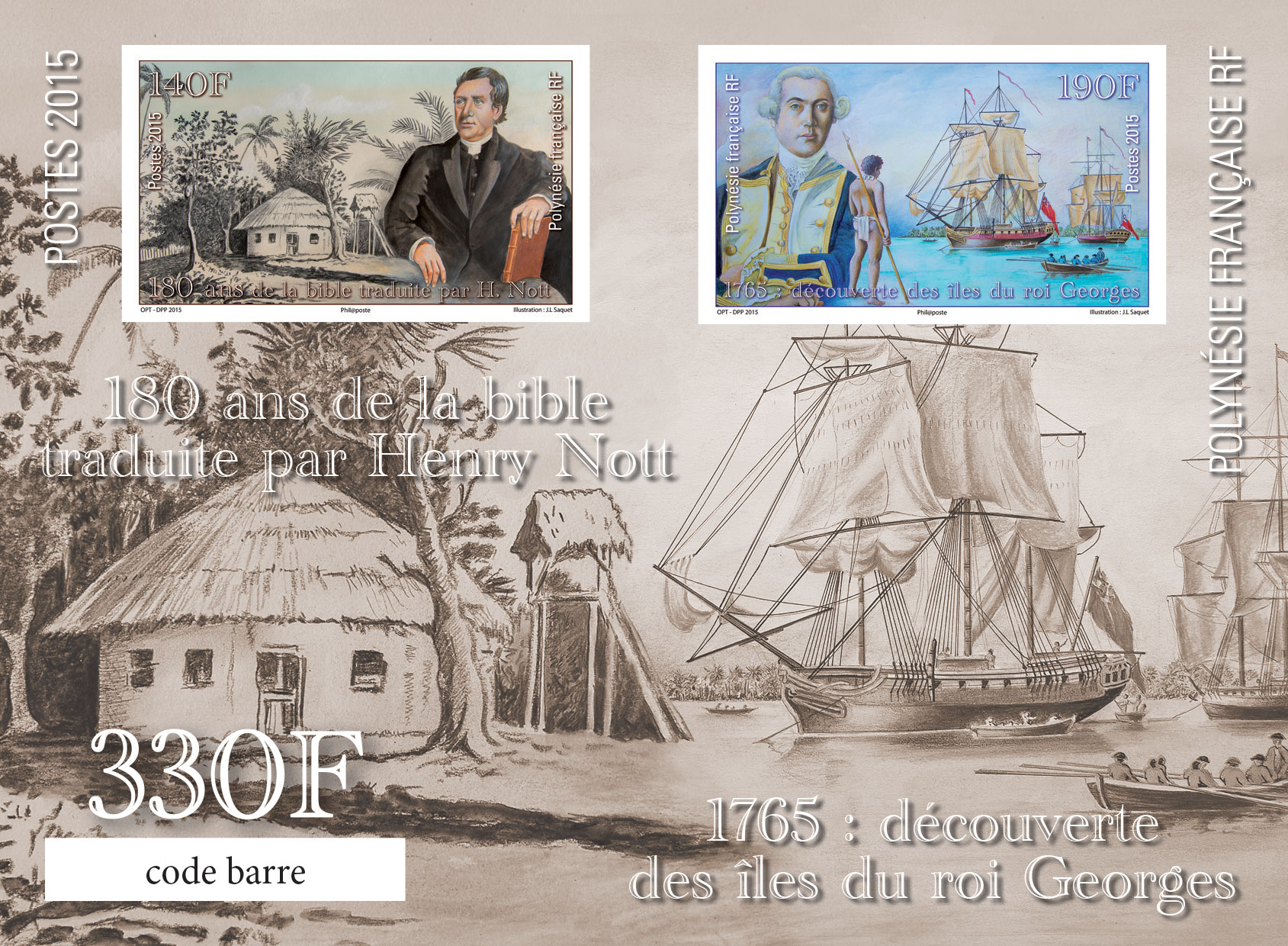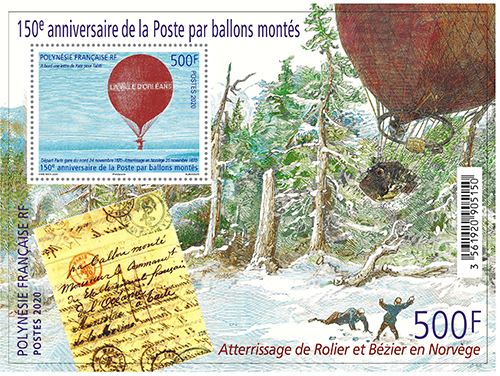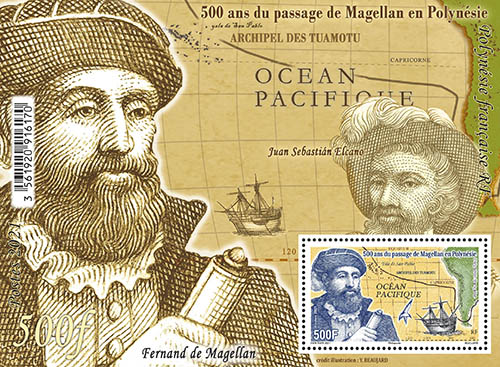1765 Découverte des îles du roi Georges et 180 ans de la bible traduite par Henry NOTT
John BYRON
Né le 08 novembre 1723 à Nottingham, John BYRON entre dans la marine anglaise à l’âge de 8 ans. En 1740, il participe à l’expédition du commodore Anson. Son navire fait naufrage dans le détroit de Magellan et ce n’est qu’après treize mois de souffrances incroyables que l’équipage est sauvé.
En 1763, au lendemain de la guerre de 7 ans, la rivalité entre la France et la Grande Bretagne prend une forme économique et les deux gouvernements décident de s’emparer des îles malouines qui commandent l’accès du pacifique. Louis Antoine de Bougainville et John Byron sont choisis par leur gouvernement respectif pour réaliser cette mission.
En juin 1764, John BYRON quitte l’Angleterre avec deux navires : la frégate Dolphin et le sloop Tamar. Il prend officiellement possession des îles malouines (Falkland islands) où, à son insu, les colons de Bougainville ont déjà bâti un camp.
Il s’élance ensuite sur les traces de Magellan, Le Maire et Roggeveen. C’est ainsi qu’il se trouve devant les atolls polynésiens de NAPUKA et TEPOTO le 07 juin 1765, sans pouvoir y accoster à cause de la forte houle et des nombreux sauvages armés alignés sur la plage.
Le 11 juin 1765, il débarque sur l’atoll de TAKAROA, pour s’approvisionner en noix de coco et en herbe à scorbut indispensables pour ses marins malades. Le récit qu’il laisse de cette journée demeure l’un des rares témoignages de la vie sur les atolls avant l’arrivée des Européens.
Il tente ensuite d’accoster sur l’atoll de TAKAPOTO, théatre du naufrage, 43 ans plus tôt, du navire Africaansche Galey de Roggeveen mais les habitants repoussent toute tentative de débarquement.
Il baptise « îles du roi Georges » le groupe formé des 4 atolls que sont Ahe – Manihi – Takapoto – Takaroa et de l’île inhabitée de Tikei.
Puis il continue sa route, manquant de justesse la découverte de Tahiti, tout comme Le Maire et Roggeveen avant lui. En mai 1766, il est de retour en Angleterre, réalisant le tour du monde en moins de deux ans, un record. En 1769, John BYRON est nommé gouverneur de Terre
Neuve. Il atteint le grade de Vice Amiral de l’escadre bleue en 1778, puis de Vice Amiral de l’escadre blanche en 1780.
Il décède le 10 avril 1786, et repose à Twickenham, près de la chapelle de l’église de la vierge marie.
Henry NOTT
C’est à la lecture des récits enthousiastes des grands navigateurs de la fin du 18e siècle, que les directeurs de la London Missionary Society (LMS) décident de faire des îles du Pacifique Sud leur premier champ missionnaire.
Ainsi, en 1796, 29 volontaires peu préparés et choisis à la hâte embarquent en direction de TAHITI à bord du navire de la LMS, le DUFF. Ils accostent en baie de MATAVAI le 05 mars 1797, à l’issue d’un voyage de 7 mois au cours duquel ils apprennent quelques rudiments de la langue tahitienne. Un an plus tard, la plupart, découragés, repartent en Angleterre. Seuls 7 d’entre eux restent.
Henry NOTT est parmi eux. Jeune maçon de 23 ans, NOTT n’a reçu qu’une instruction rudimentaire mais il se montre particulièrement doué pour l’apprentissage du tahitien. Avec John DAVIES, jeune missionnaire d’origine galloise arrivé peu après lui, il décide de traduire la bible en tahitien. C’est une entreprise titanesque.
La langue n’existe que sous forme orale. La syntaxe est un véritable obstacle. Les mots sont une succession de voyelles coupés de rares consonnes dont les prononciations diffèrent. De plus, ils sont quelquefois déclarés tabous et doivent alors être remplacés. Ecrire le tahitien s’avère difficile, car l’alphabet latin n’en rend pas les sons. Au terme d’interminables débats sur la phonétique et l’orthographe, les missionnaires forgent de nouvelles orthographes.
Ils mènent leurs travaux au milieu de guerres incessantes entre les nombreux clans de TAHITI. Dans ce contexte agité, NOTT devient l’ami du roi POMARE II, qui lui assure sa protection. Battu en 1808, le roi se réfugie sur l’île voisine de MOOREA, en compagnie de NOTT. Sur place, le roi apprend à lire et à écrire, et prépare méthodiquement sa revanche. La congrégation chrétienne s’agrandit et compte alors quelques 500 fidèles dans toutes les îles. NOTT poursuit ses travaux, crée une école biblique et, en collaboration avec DAVIES, et avec l’assistance de TUAHINE, un tahitien dévoué resté à ses côtés durant toutes ces années, il achève la traduction de l’évangile de Luc en 1814.
De retour sur l’île de TAHITI en 1815, le roi POMARE II et ses forces chrétiennes battent le puissant chef païen OPUHARA lors de la bataille de FEI PI. Le roi déclare alors que l’évangile chrétien enseigne l’amour et le pardon. Il n’y aura aucune poursuite, aucun massacre. Impressionnés, les vaincus renoncent à leurs anciennes croyances dans les semaines qui suivent. En 1816, toute la population est chrétienne. Dans le même temps, des renforts considérables arrivent de la LMS.
En 1817, la 1re presse est installée à MOOREA, et le roi y imprimera lui-même les 1ères pages de Polynésie. En 1819, la traduction des Evangiles, des Actes des Apôtres et du livre des Psaumes est achevée. Le roi POMARE II est baptisé. NOTT écrit le code
POMARE, premier statut du pays. Enfin, le 18 décembre 1835 à 01h35, après plus de 30 années de travail assidu, Henry NOTT, pose sa plume. La Bible est traduite dans son intégralité. NOTT se rend en Angleterre en 1836 pour la faire imprimer. Il présente la première édition de la Bible en tahitien à la reine Victoria le 08 juin
1838, puis rejoint TAHITI en 1840 avec 3 000 exemplaires du Livre.
Il y meurt en 1844, à l’âge de 70 ans, et est, à sa demande, enterré à proximité de son ami le roi POMARE II, décédé quant à lui en 1821.
Seul livre à la disposition de la population pendant près de 100 ans, la Bible est devenu un élément fondamental de la culture polynésienne.
En donnant une forme écrite au tahitien, les missionnaires ont protégé cette langue et posé les bases de la traduction d’autres langues du Pacifique Sud.
John BYRON
Born on 8th November 1723 in Nottingham, John BYRON joined the English Navy at the age of 8. In 1740, he took part in Commodore Anson’s expedition. His ship wrecked in the
Magellan Strait and it was only after 13 months of incredible sufferings that the crew got rescued.
In 1763, after the Seven Year’s War, the rivalry between France and Great Britain took on an economic form and the two governments decided to take hold of the Falkland Islands, as the former were the gateway to the Pacific. Louis Antoine de Bougainville and John Byron were appointed by their respective governments to carry out that mission.
In June 1764, John BYRON left England with two ships: the frigate Dolphin and the sloop Tamar. He officially took possession of the Falkland Islands, where settlers of Bougainville had already built a camp, without him knowing it.
He then followed the wakes of Magellan, Le Maire and Roggeveen. This is how he sailed past the Polynesian atolls of NAPUKA and TEPOTO on 7th June 1765, without being able to land because of the heavy swell and of the many armed savages lined up along the beach.
On 11th June 1765, he landed on the atoll of TAKAROA, in order to get supplies of coconuts and scurvy grass that was indispensable for his ill seamen. His account of that day remains one of the few evidences of what life was like on the atolls before the arrival of the Europeans.
He then tried to land on the atoll of TAKAPOTO, where, 43 years earlier, Roggeveen’s ship Africaansche Galey had wrecked, but the islanders rebuffed all landing attempts.
He gave the name “King George Islands” to the group made of 4 atolls: Ahe – Manihi – Takapoto – Takaroa and to the uninhabited island of Tikei.
Then he continued on his way, narrowly missing the discovery of Tahiti, just like Le Maire and Roggeveen before him.
In May 1766, he was back in England, completing a roundthe- world voyage in less than two years – a record.
In 1769, John BYRON was appointed Governor of Newfoundland. He was promoted to the rank of Rear Admiral of the Blue Squadron in 1778, and then Rear Admiral of the White Squadron in 1780.
He died on 10th April 1786, and rests in Twickenham, near the Chapel of St Mary’s Church.
Henry NOTT
When they read the enthusiastic stories related by the great navigators, the directors of the London Missionary Society (LMS) decided that the South Pacific Islands would be their first mission field.
This is how, in 1796, 29 unprepared and hastily selected volunteers embarked on the LMS ship, the DUFF, bound for TAHITI. They landed in MATAVAI on 5th March 1797, after a journey of 7 months during which they learnt the basics of the Tahitian language. A year later, most of them, discouraged, sailed back to England. Only 7 remained. Henry NOTT was one of them.
A young mason of 23 years of age, NOTT only had basic education but he was particularly gifted at learning Tahitian. With John DAVIES, a young Welsh missionary who had arrived soon after him, he decided to translate the Bible into Tahitian. That turned out to be a daunting undertaking.
The language existed only in its spoken form. Syntax was a major obstacle. Words were a succession of vowels interspersed with rare consonants whose pronunciations differ. Moreover, they were sometimes considered taboo and therefore needed to be replaced.
Putting the Tahitian language into written form was really difficult because the Latin alphabet could not transcribe its sounds. After endless debates about phonetics and spelling, the missionaries created new spellings.
They carried out their work in the midst of endless wars between the many clans of TAHITI. In that troubled context, NOTT made friend with King POMARE II, who ensured his protection. Beaten in
1808, the King sought refuge on the neighbouring island of MOOREA, in the company of NOTT. There, the King learnt to read and write and methodically prepared his revenge. The Christian congregation had widened and, by then, comprised some 500 believers throughout all the islands. NOTT carried on his work, set up a Bible school and, in collaboration with DAVIES and with the assistance of TUAHINE, a devoted Tahitian who remained on his side during all those years, he completed the translation of the Gospel by Luke in 1814. Back on the island of TAHITI in 1815, King POMARE II and his Christian forces defeated the powerful pagan chief OPUHARA during the battle of FEI PI. The King then proclaimed that the Christian Gospel teaches love and forgiveness. There would be no prosecution, no massacre. Impressed, the defeated turned their back on their previous beliefs in the following weeks. In
1816, the whole population had turned Christian. In the meantime, considerable backup arrived from the LMS.
In 1817, the first press was set up on MOOREA, and the King himself published the first pages of Polynesia. In 1819, the translation of the Gospels, of the Acts of the Apostles and of the Book of
Psalms was completed. King POMARE II was baptized. NOTT drafted the POMARE Code, the first statute of the country.
Lastly, on 18th December 1835 at 01.35 AM, after more than 30 years of painstaking work, Henry NOTT, put his pen away. The Bible was fully translated. NOTT returned to England in 1836 in order to have it printed. He presented the first edition of the Bible in Tahitian to Queen Victoria on 8th June 1838, and then sailed back to TAHITI in 1840 with 3,000 copies of the Book. He died there in 1844, at the age of 70. In accordance with his last will, he got buried next to his friend King POMARE II, who had died in 1821.
As the only book made available to the community for about 100 years, the Bible became a fundamental feature of Polynesian culture. By providing a written form to the Tahitian language, the missionaries protected that language and laid down the foundation for translation into other languages of the South Pacific.





Avis
Il n’y a pas encore d’avis.